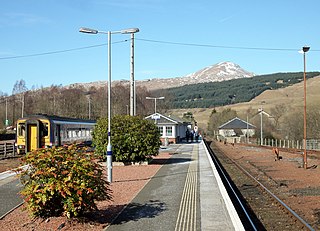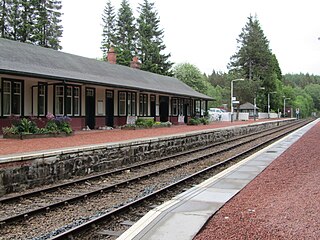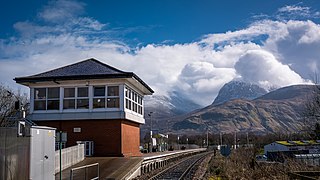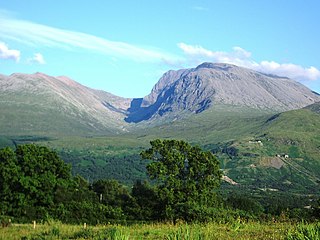
The Caledonian Canal connects the Scottish east coast at Inverness with the west coast at Corpach near Fort William in Scotland. The canal was constructed in the early nineteenth century by Scottish engineer Thomas Telford.

The West Highland Line is a railway line linking the ports of Mallaig and Oban in the Scottish Highlands to Glasgow in Central Scotland. The line was voted the top rail journey in the world by readers of independent travel magazine Wanderlust in 2009, ahead of the notable Trans-Siberian line in Russia and the Cuzco to Machu Picchu line in Peru. The ScotRail website has since reported that the line has been voted the most scenic railway line in the world for the second year running.

Arrochar and Tarbet railway station is a railway station on the West Highland Line in Scotland. It stands between the villages of Arrochar and Tarbet.

Rannoch railway station, on the West Highland Line, serves the area of Rannoch in Perth and Kinross, Scotland. Its remote location on Rannoch Moor is picturesque and makes it attractive to walkers. The station has a tea room and visitor centre. In 2017, Simon Jenkins reported it to be one of the best 100 stations in Britain.

Crianlarich railway station is a railway station serving the village of Crianlarich in Scotland. It is located on the West Highland Line. The routes to Fort William/Mallaig and Oban diverge after this station. Access to the platform is via a flight of stairs from a subway that runs underneath the tracks, from the car park which is slightly lower than the station itself.

Bridge of Orchy railway station is a railway station in the village of Bridge of Orchy in the west of Scotland. This station is on the West Highland Line. Being an island platform, access is via a subway.

Tulloch railway station is a rural railway station in the remote Tulloch area of the Highland region of Scotland. This station is on the West Highland Line, 105 miles (169 km) north of Glasgow Queen Street.

Spean Bridge railway station is a railway station serving the village of Spean Bridge in the Highland region of Scotland. This station is on the West Highland Line.

Fort William railway station is a railway station serving the town of Fort William in the Highland region of Scotland.

Banavie railway station is a railway station on the West Highland Line serving the village of Banavie, although it is much closer to Caol, Scotland. To continue on to the next station at Corpach, trains must pass over the Caledonian Canal at Neptune's Staircase, a popular tourist attraction.

Mallaig railway station is a Category C listed railway station serving the ferry port of Mallaig, Lochaber, in the Highland region of Scotland. This station is a terminus on the West Highland Line, 41 miles (66 km) by rail from Fort William and 164 miles (264 km) from Glasgow Queen Street.

Garelochhead railway station is a railway station serving the village of Garelochhead, on the Gare Loch, in Scotland. This station is on the West Highland Line and is a boundary station for SPT.

The West Highland Railway was a railway company that constructed a railway line from Craigendoran to Fort William and Mallaig. The line was built through remote and difficult terrain in two stages: the section from Craigendoran to Fort William opened in 1894, with a short extension to Banavie on the Caledonian Canal opening in 1895.

Banavie is a small settlement near Fort William in the Highland Council Area of Scotland. One of the closest villages to Ben Nevis, it is about 4 kilometres northeast of Fort William town centre, next to Caol and Corpach.

The Invergarry and Fort Augustus Railway was a branch-line railway built in Scotland, connecting the named places with the main line at Spean Bridge. It opened in 1903.
The Mallaig Extension Railway is a railway line in Highland, Scotland. It runs from Banavie Junction (New) on the Banavie Pier branch of the West Highland Railway to Mallaig. The previous "Banavie Junction" closer to Fort William was renamed "Mallaig Junction" upon opening of the Mallaig Extension Railway. The line is still open as part of the West Highland Line.
Fort William Junction is a railway junction on the West Highland Line in Scotland, located to the east of Fort William railway station. It is where the railway to Mallaig connects with the Glasgow to Fort William railway.
The Glasgow, Dumbarton and Helensburgh Railway was independently sponsored to build along the north of the River Clyde. It opened in 1858, joining with an earlier local line serving Balloch. Both were taken over by the powerful North British Railway in 1865, and for some time the line was the main route in the area. As industry developed other lines were opened to serve it, and the line formed the core of a network in the area.

Lech-a-Vuie Platform railway station(NM860813), Lechavuie or Lech-a-Vute was not constructed for public use. It stood close to the A830 road to the east of Loch Eilt near the Allt-a-Ghiughais burn and below Doire Dhamh on the West Highland Railway's extension to Mallaig. It stood in between the still extant Glenfinnan and Lochailort stations. At first it only served the needs of shooting parties on the Inverailort Estate owned by the Common-Head family, however it was later used by the army and navy during WWII and closed in the 1970s. Lech-a-vuie was 18.5 miles (30 km) from Mallaig Junction and stood at the summit of the line at a height of 379 feet.

Whistlefield, later Whistlefield Halt, was a minor station on the West Highland Line 10.30 miles from Craigendoran Junction railway station near the hamlet of Portincaple on Loch Long, Argyll and Bute, Scotland. Opened in 1896 by the West Highland Railway, it was built on a single track section without a passing loop in between Garelochhead and Glen Douglas and closed by the British Railways Board in 1964.


















